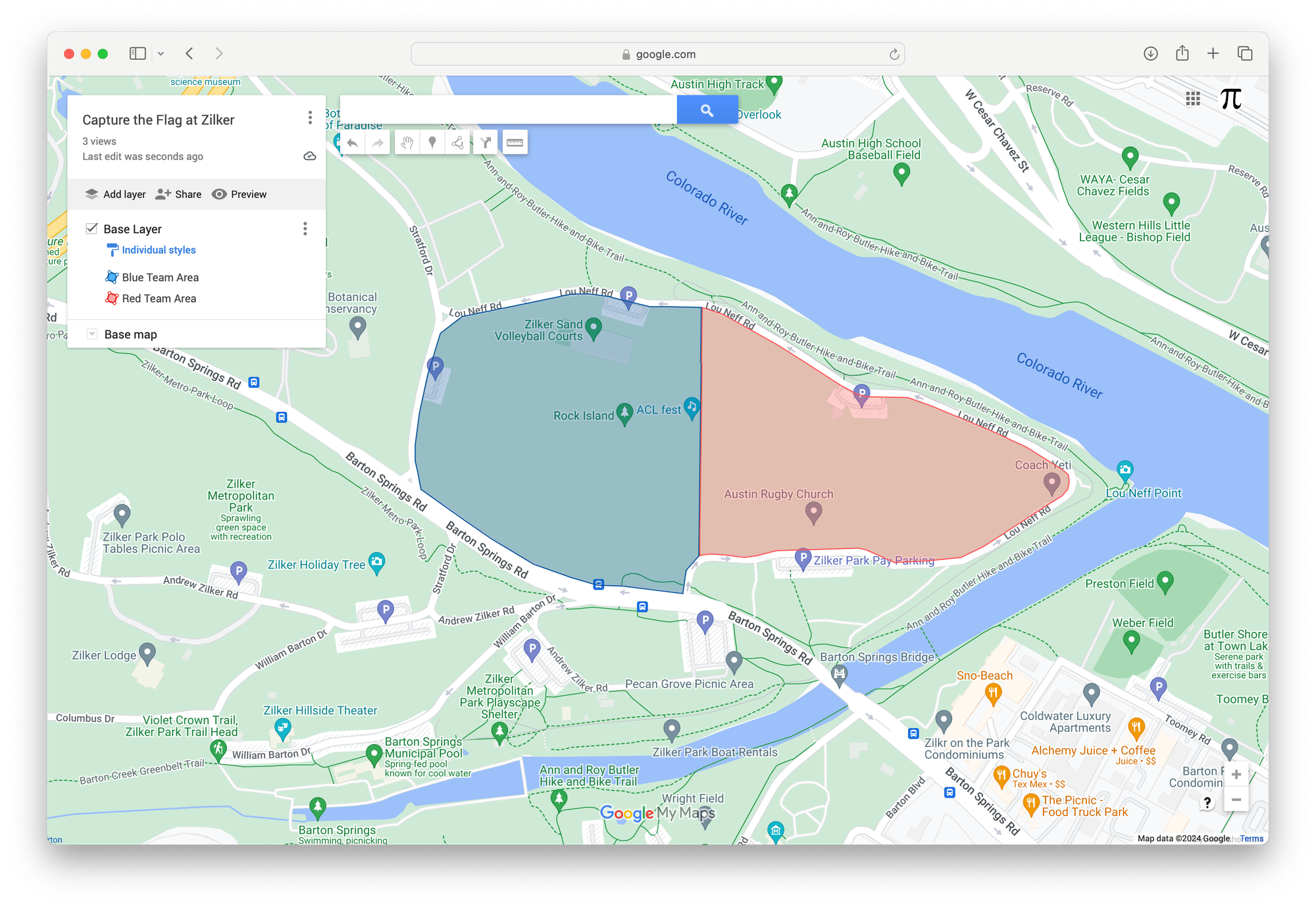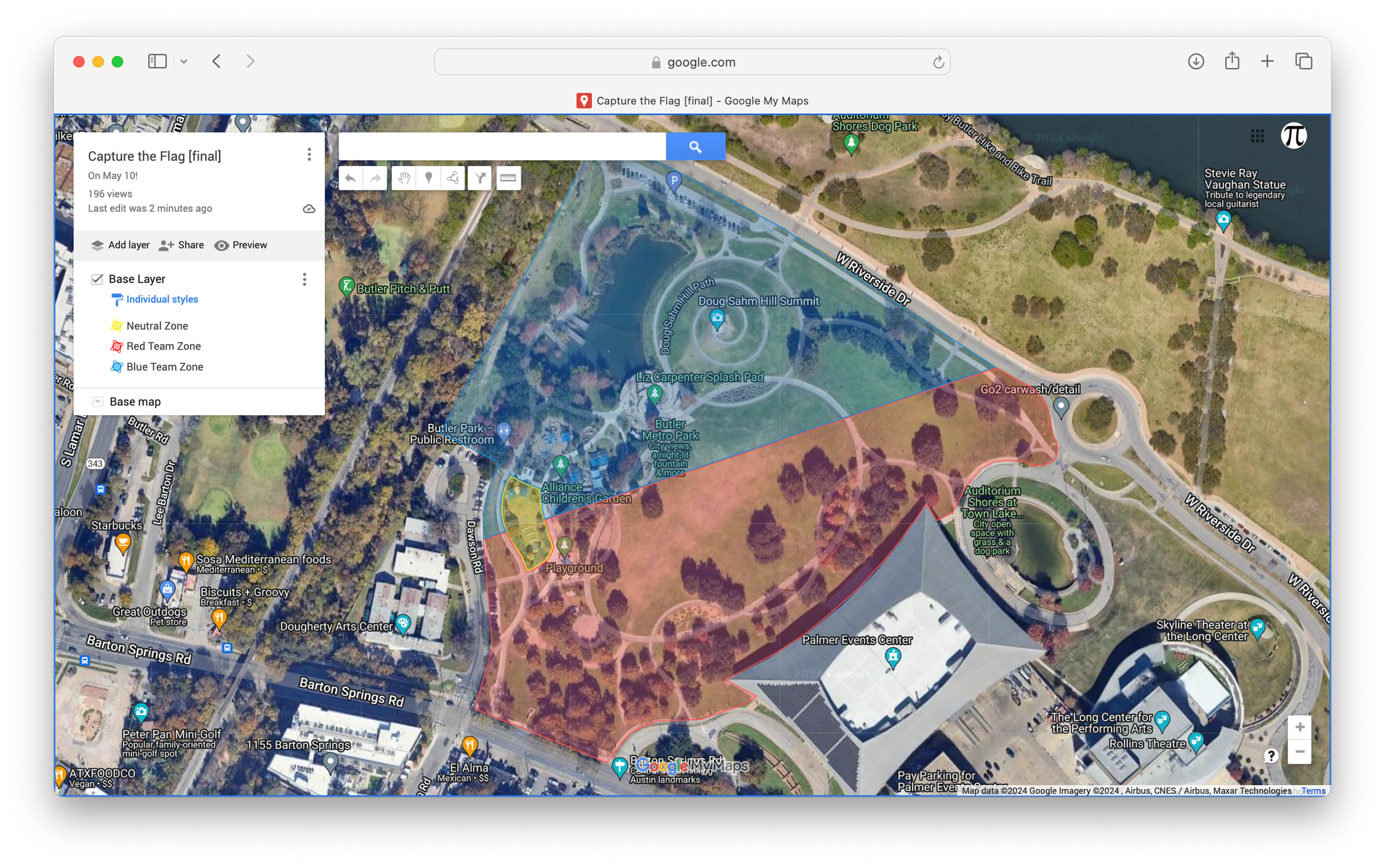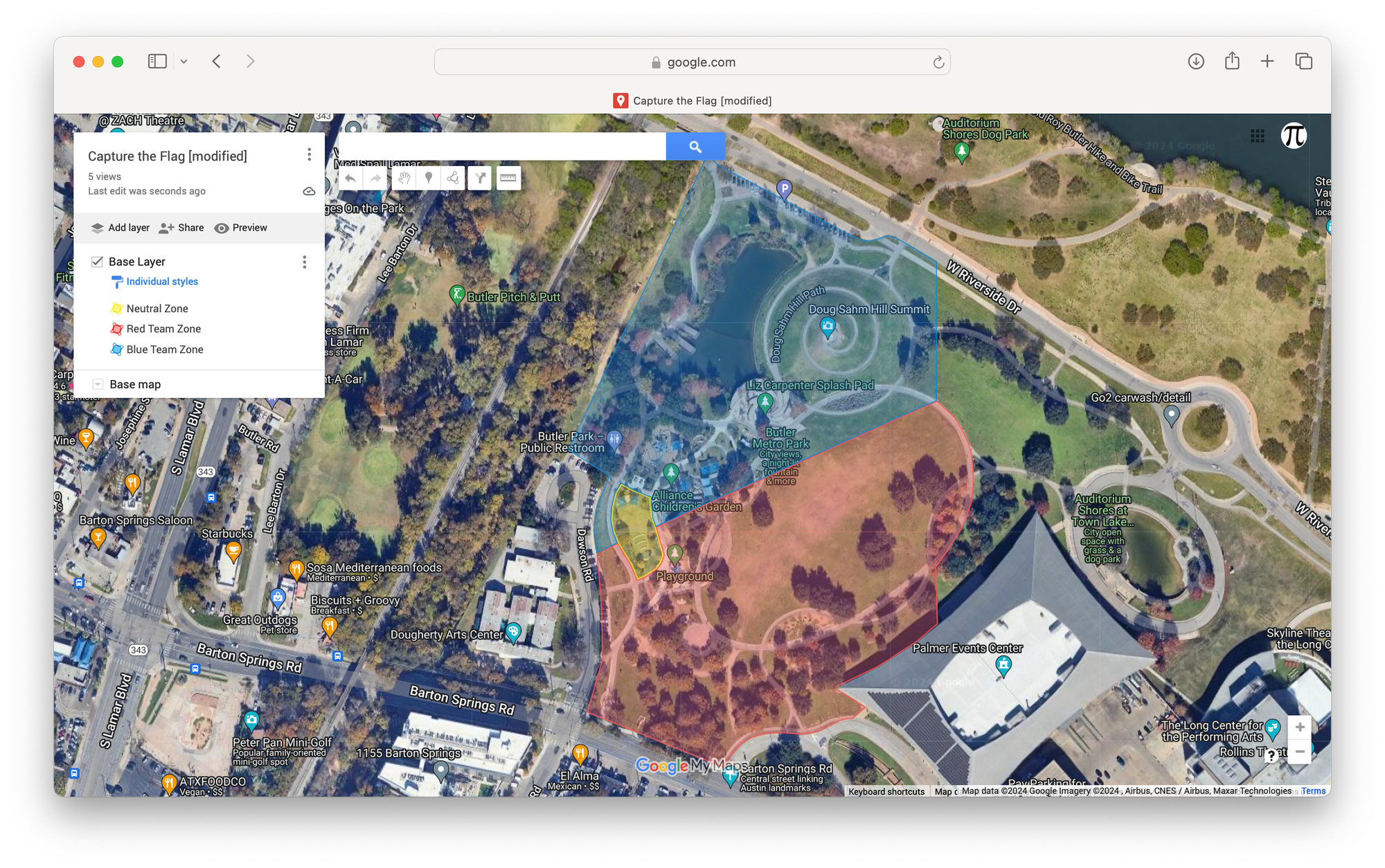I hosted a spectacular 20-acre game of Capture the Flag [#61]
Many players said afterward: "This was the best game of Capture the Flag, like... EVER."
![I hosted a spectacular 20-acre game of Capture the Flag [#61]](/content/images/size/w1200/2024/05/joshua-hoehne-wWkCAnmFF20-unsplash.jpg)
This is the story of how I hosted the most epic game of Capture the Flag ever. I've broken it into parts so it's easier to read.
I: Inception
“Listen, there's something you should know about me... about inception. An idea is like a virus, resilient, highly contagious. The smallest seed of an idea can grow. It can grow to define or destroy you.” – Dom Cobb, Inception (2010)
I was eating steak and potatoes with my family & another family on a lovely evening in late March. Since I would graduate high school in May, their family's father (who is named Taylor) gave me some life advice.
He suggested I do more (good-natured) shenanigans in my life. I think that advice should be required advice for everyone. Life is too short to always "go with the flow" — because when you're older, you'll wish for good memories of your youth. The best memories come from doing silly/fun shenanigans with your friends.¹
Because of Taylor's advice, for the next few weeks, I had this nagging voice in the back of my head. The voice said "yo Nathan you should really do some shenanigans before you and your friends all graduate and go your separate ways." So I thought each day about good-natured shenanigans — you know, the ones that wouldn't get me in trouble. And then one day, I stumbled across a YouTube video of four grown men playing a 96-hour game of Capture the Flag across the entirety of Japan.²
I showed the series to my sister, and she and I were both hooked. We watched the entire series (which is ~280 minutes long!) in just three short days. Then I realized exactly what my next shenanigan would be. I couldn't fly to another country and pay for miles and miles of transit like the Jet Lag team did. But I could very well construct a large game of Capture the Flag at a local park and get all my friends to come. Because who doesn't like a great game of Capture the Flag?
I was determined to execute on my awesome idea, but I needed to do some planning first. After all, I wanted this Capture the Flag game to be certifiably epic, so I couldn't just whip it all together in one afternoon.
II: Planning
“A goal without a plan is just a wish.” – Antoine de Saint-Exupéry
My first step was to find a public park to play Capture the Flag in. I quickly identified two candidates: Zilker and Auditorium Shores. Then I used Google MyMaps to quickly sketch a possible playing area. Here's what my first prototype looked like:

I quickly grew to dislike my first prototype. The playing area:
- was far too large (almost 50 acres)
- had almost no interesting terrain (like trees or natural obstacles)
- was substantially uneven (red team has a clear advantage)
So I ditched Zilker and moved my efforts to Auditorium Shores. I made 3-4 more prototype maps, modifying them when the territories were unequal or when the boundaries were unclear. I finally came up with the finished map after about 3 hours of work:

I also invited 31 of my friends to play Capture the Flag, because I wanted as many people to play as possible. Finally, I had to order $120 worth of equipment on Amazon:
- 30 flag football belts & 90 accompanying flags (15 blue belts, 15 red belts, 45 blue flags, 45 red flags)
- 48 orange cones (2 packs of 24)
- 8 playground balls (4 blue, 4 red)
What is that equipment for? I'll tell you about it in the next section.
III: Game Design
"To design a game is to imagine the person who will eventually play it." – Gabrielle Zevin, Tomorrow and Tomorrow and Tomorrow
I keep one 'golden rule' in mind for large games like this: they must be easy to explain in three minutes or less. This is because people invariably forget rules if they are too complicated.
I kept many of the classic Capture the Flag rules, because they are intuitive and form the basis of the game. But I made a few key changes:
- There is a neutral zone (the yellow zone on the finished map) that no one may be tagged in. The neutral zone is important, as you'll see below.
- Each team has two "flags" (aka playground balls) instead of one. To win, you must bring both the "flags" from the opposing team's side back to the neutral zone. The "flags" are playground balls because it's more fun if you can throw them to your teammates.
- Everyone wears a flag football belt with their team color. This eliminates all arguments related to "did this person really tag this other person?" To tag someone, you have to rip one of the three flags off their belt.
- If you are tagged (ie. someone pulls one of your belt flags while you're in enemy territory), you cannot participate in the game until you walk back to the neutral zone and wait 1 minute. This is better than having "jail", because with "jail", some players may be out of the game for a long time.
Those are the main changes. Everything else is broadly the same as normal Capture the Flag.
IV: Rules
"You have to learn the rules of the game. And then you have to play better than anyone else." – Dianne Feinstein
Here's the whole list of initial rules. Feel free to skip this part and go read about the strategy in the next section, because this section is kind of boring.
- Play nice & be honest. No full-body contact.
- Players may not leave the playing area during the game.
- There is a red team and a blue team, each with an equal number of players. Everyone wears a flag football belt of their team color.
- The first team to bring back both enemy "flags" (balls) from the enemy territory to the neutral zone wins the game.
- If you are tagged (ie. someone pulls one of your belt flags while you're in enemy territory), you cannot participate in the game whatsoever until you walk back to the neutral zone and wait 1 minute.
- You cannot be tagged in the neutral zone.
- Your team must place "flags" of your own team's color:
- on the ground;
- such that they are clearly visible from two distinct angles;
- at least 18 feet away from all boundary lines;
- at least 18 feet away from your team's other flag.
- You cannot move "flags" of your own team's color, except in exceptional circumstances (prevent them from going into the lake, prevent them from rolling into the road, etc).
- You must always stay 6 feet away from balls of your own team's color, unless you are adjusting them momentarily.
- If you are tagged while carrying a "flag", you must drop the "flag" where you stand.
- You may throw a ball if you have it. But if the ball touches the ground after your throw, you are automatically tagged and the other team may move the ball back to where you stood when the ball touched the ground.
V: Strategy
"All warfare is based on deception." – Sun Tzu, The Art Of War
I invited thirty-one people, and nineteen people showed up by the time I explained all the rules. That made for a solid game of 10v10 Capture the Flag. There was a lot of interesting strategy that emerged throughout the three games we played!
- Flag Location. In the first game, both teams had the sound strategy to hide their flags near the back of the zone. This makes intuitive sense: it's harder to find & retrieve flags far from the halfway line. But this also made the flag locations easy to predict. So in the second game, both teams placed one of their flags in more unconventional locations. This made them harder to find, but when they were found, they were much easier to bring back to the neutral zone. In the third game, one team even stationed zero defenders around one of their flags, which worked very well (the other team couldn't find it).
- Offense vs. Defense. I thought the game rules would encourage considerably more offense than defense (because "respawning" after being tagged is a pretty easy endeavor). I was wrong — there was a lot more defensive play than I expected. But in the games we played, the team with the more aggressive offense almost always won.
- Endurance over Speed. I didn't realize how big the playing area was until we actually started playing. After just ~10 minutes, most of the players were exhausted, and the advantage pivoted to players who had more endurance (and could evade being tagged for longer). I thought the game would be dominated by the fastest sprinters, and that was not at all true.
VI: Aftermath
"Be prepared." – Motto of the Boy Scouts
I had the foresight to bring a cooler full of two gallons of water, two bags of apples, and a bunch of individually-wrapped cheddar cheese slices.³ This was an excellent decision. The snacks and the drinks really helped people stay motivated throughout the 90 minutes that we played. I will definitely bring snacks and drinks the next time I host Capture the Flag.
I also redid the map. Many of the players (including myself) thought it was too big, so I cut off a large portion of the playing area that most players never ventured into. The new map (which is only ~16 acres large) should encourage faster play & facilitate better team communication.

Everyone who came really enjoyed Capture the Flag, and there were no rule disputes or proposed rule changes. I'm really happy that all my planning turned out well, and I'm excited to host more games of Capture the Flag while I'm attending UT Austin.
VII: Footnotes
¹ If you don't believe me, ask anyone over the age of 30 this question: "What are your best memories from your youth?" I can 90% guarantee you they'll say "having fun with my friends" or "doing <cool/awesome/slightly-stupid> thing with my buddies".
² I want to highlight how awesome the Jet Lag: The Game channel is. They make high-quality, super-fun videos about massive & intriguing games they've dreamt up. Would highly recommend watching a few of their videos.
³ I stored the ice packs (for the cooler), the apples, the cheddar slices, and the waters in the school fridge and freezer. Unfortunately, I mixed the freezer and fridge up somehow (?? silly me) and placed the apples, cheddar slices, and waters in the freezer and the ice packs in the fridge. When I realized my mistake, I was very annoyed. But it ended up working out, because slightly-frozen apples are actually delicious & the water was slightly icy, so it stayed extra cool in the 80 °F heat.
![I organized a 10-day game of tag with 10 of my friends [#70]](/content/images/size/w960/2025/03/History-Of-Tag.jpg)
![My favorite games this summer [#64]](/content/images/size/w960/2024/07/dennis-cortes-saa-4nYJWns-unsplash-2.jpg)
![Mao: a wonderfully infuriating card game [#58]](/content/images/size/w960/2024/03/erik-mclean-p1Xx215ooiM-unsplash.jpg)
![The ultimate guide to Wikipedia racing [#57]](/content/images/size/w960/2024/05/wikipedia-min-1.png)